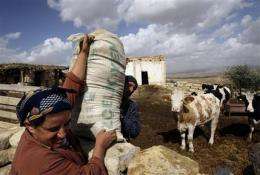Village ravaged by cancer in Turkey's Cappadocia

(AP) -- The caves, rock houses and fantastical stone formations in Turkey's Cappadocia draw tourists from around the world. Nestled among the natural wonders, however, lies a village where the earth is believed to deliver death rather than rewards.
Nearly half the deaths in this impoverished village and two others nearby are from a rare cancer known as mesothelioma - which can be caused by a mineral that's found in abundance in the area. Local authorities are so alarmed that a relocation of all residents is under way.
"The plan is to demolish the old village, bury it in 1 1/2 meters (yards) of earth and plant over it," Mayor Umit Balak said.
The Turkish government, however, hasn't made a final decision on whether to bury Tuzkoy under dirt, pave over it with asphalt, or just try to keep people away.
Dubbed "cancer village" in the media, Tuzkoy was declared a hazardous zone in 2004 and about 250 families have moved to new housing one mile (1.6 kilometers) away. The rest of the population of 2,350 is expected to move when additional homes are ready. The move is subsidized by the state.
Mesothelioma - cancer of the lining of the chest or abdomen - has also been the scourge of the nearby villages of Sarihidir and Karain.
"The number of cases of mesothelioma in Tuzkoy has been about 600 to 800 times higher than world standards," said Murat Tuncer, who heads the Health Ministry department to fight cancer.
About 48 percent of all deaths in the three villages are from mesothelioma; the area accounts for about a quarter of the 40 to 60 new cases of mesothelioma in Turkey every year, Tuncer said. Official figures on the total number of mesothelioma deaths were unavailable, but several hundred villagers are believed to have died from the cancer since the 1980s, when authorities began to notice the problem.
Tuzkoy's inhabitants are believed to have inhaled fibers of the mineral erionite in stones and paints they used to build homes as well as in roads and fields. Moving them just a short walk away should eliminate the risk, said Tuncer.
Erionite, found in volcanic rock, is classified as a Group 1 carcinogen by the International Agency on Cancer Research, the cancer arm of the World Health Organization. That means it's a substance that definitely cause cancer; other carcinogens in that group include asbestos, arsenic and tobacco.
Izzettin Baris, a retired professor who has researched mesothelioma in the area, said erionite is found in various parts of the world, including in the U.S. state of Nevada.
"In most of those countries the cancerous material is generally found far deep underground. In Turkey, however, it is very close to the surface," Baris said. "And people take the rocks which have erionite and build houses with them."
Some experts cite other possible factors for the high cancer rates, including the genetic disposition of some villagers.
A few residents also blamed lifestyle: "The people ... spend all day in smoke-filled coffeehouses," said farmer Muharrem Sevim, a 44-year-old father of three.
There is only one doctor, one nurse and one midwife at Tuzkoy. There are two cemeteries in the village and both are full. They are now opening a third cemetery.
"We are lost in different rumors and darkness," said Ismet Bilgen, a mother of six and grandmother of five. "I don't know what we should trust. May God help us!"
The government considered knocking down the village and burying it after relocating all of its residents as far back as 1999. Financial constraints, bureaucratic hurdles and a string of unstable governments have slowed down efforts to address the problem over the years.
Tuncer said the government was still considering the best option to rehabilitate Tuzkoy and minimize the risk of cancer. Parliament has also set up a committee to look into ways to deal with the problem.
Authorities hope that "New Tuzkoy" will be completed by the end of 2011. Villagers make a living mainly from agriculture, livestock, and from a nearby salt mine.
Tuzkoy is 22 miles (35 kilometers) from the nearest sites where tourists marvel at natural stone formations, and 30 miles (50 kilometers) from Urgup, Goreme and other towns where the local tourist industry is concentrated.
There is no indication of similar health threats at these popular sites, which were formed by volcanic deposits millions of years ago and later sculpted into underground cities and other dwellings by early civilizations.
Tuzkoy has about 1,000 houses, and some areas feel like a ghost town. Many houses are used to keep only animals. Some are locked or just abandoned.
"It's true, people die of cancer here. There's nothing shameful in admitting it," said Ahmet Balta, a 51-year-businessman who said many of his own relatives had died of cancer at a young age. "Academics, the government and the media have to take the problem seriously."
©2010 The Associated Press. All rights reserved. This material may not be published, broadcast, rewritten or redistributed.
















